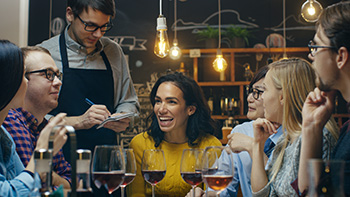A restaurant owner’s guide to reducing liability exposures

Restaurants have potentially serious general liability issues due to premises and operations exposures—but restaurant owners and managers can help to reduce patron injuries and claims by implementing safety best practices.
What’s the risk to your business?
Consider these statistics from leading authorities:
- In the U.S., according to the National Safety Council, nearly 25% of all occupational injuries resulting in days away from work are the result of slips, trips and falls.1
- Roughly 48 million people get sick from a foodborne illness in the U.S. each year, 128,000 are hospitalized and 3,000 die.2
- According to the National Fire Protection Association (NFPA), an average of 7,640 structure fires in eating and drinking establishments were reported to U.S. fire departments annually between 2006 and 2010, with an associated $246 million in property damage per year.3
Some practical advice for safe restaurant operation
Restaurant owners and managers can help reduce the chances of patron injuries and insurance claims by implementing safety best practices in each of the following areas.
Slip and fall safety
Spills, slippery floors, poor floor and parking lot maintenance, dim lighting and crowded dining areas all are contributors to general liability claims by patrons.
To help prevent slips and falls:
- Perform timely weather-related maintenance of parking lots and entry areas
- Conduct periodic inspection/repair of flooring, stairs, sidewalks and parking lots
- Install handrails on all stairways and ramps
- Maintain adequate interior and exterior illumination
- Apply “traffic-yellow” paint on speed bumps and tire stops
- Ensure rapid cleanup of spills and use of movable “Caution” signage
- Apply slip-resistant floor materials and treatments (including on dance floors)
- Situate restroom soap and hand dryers/paper towel dispensers to minimize soap and water drippings in areas where patrons walk
For more information, read our Preventing Slips and Falls article and download our Slip and Fall Prevention poster, which can be displayed on your bulletin board as a constant reminder to restaurant staff of the need for safety.
Foodborne illness prevention
Employee health and cleanliness are critical to protecting customers against disease, and the presence of a certified food manager can further help to reduce the incidence of foodborne illnesses.
To employ the best practices for personal hygiene and food handling:
- Educate employees about food safety and hygiene
- Implement a hand washing program
- Install hands-free ice dispensers
- Require the use of disposable gloves by employees who come in contact with food
- Restrict sick employees from food handling areas
- Insist on employee restroom cleanliness
- Provide touch-free soap and paper towel dispensers/dryers
- Implement a stored-food dating system with shelf-life labels
- Be sure to maintain proper refrigeration and cook all food at appropriate temperatures
- Create formal kitchen and dishwasher sanitation procedures
- Avoid cross contamination through proper cooking and surface cleaning procedures, kitchen tool cleaning and supplies management
For more information, download our bulletin on Proper Food Handling and Storage.
Egress and fire safety
While the probability of a fire may be low, the potential for loss of life once a fire occurs is high due to the large number of people often seated in a restaurant at one time.
To help prevent fires and implement appropriate egress procedures:
- Use kitchen hoods approved by the NFPA, which meet UL standards
- Implement a hood and ductwork inspection and cleaning program
- Install appropriate UL 300 fire suppression systems and Class K extinguishers for cooking areas
- Conduct suppression system inspections
- Install an accessible gas shutoff valve
- Limit combustibles stored in or near cooking areas
- Install smoke and fire alarms wherever needed
- Adhere to maximum occupancy regulations
- Regularly test emergency power sources for egress lighting, as well as elevators and escalators
- Ensure egress areas are maintained free and clear
- Inspect and maintain elevators and escalators
Other patron safety practices
Below are other important safety practices all restaurant owners should implement:
- Train staff to perform the Heimlich maneuver and CPR and to use a defibrillator
- Perform liquor service ID checks and implement an intoxicated customer policy
- Limit patron access to employee-only and adjacent areas
- Implement a maintenance program to inspect and repair furniture and fixtures
- Provide server training in carrying trays and hot dishes or beverages
- Use only highly-trained staff for tableside cooking or entertainment
- Separate delivery areas from patron parking and entry areas
- Implement emergency evacuation plans and conduct drills to ensure preparedness
- Use credit card point-of-sale systems compliant with Payment Card Industry Data Security Standard (PCI-DSS) requirements
- Perform motor vehicle record (MVR) and background checks for valet staff
- Ensure parking lots contain minimal shrubbery and vision obstruction for patron security, and use exterior cameras, wherever appropriate
